
Austria - electric locomotive hauled trains of federal railways ÖBB
For a full scale picture, please click on the picture shown !
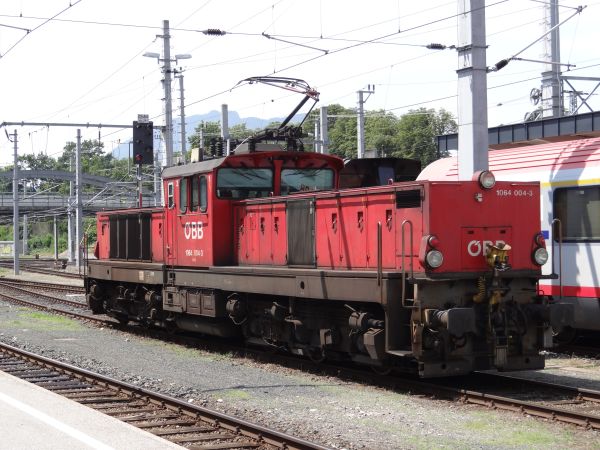
ÖBB class 1064 electric shunter at Villach station 6.7.2015. Br1064 is the "big brother" of the very common Br1063. 1064 is
longer and heavier and intended especially for hump hill shunting of heavy cargo trains. ÖBB has ten of them. They were built
1984 to 1990.
Photo by Ilkka Siissalo.
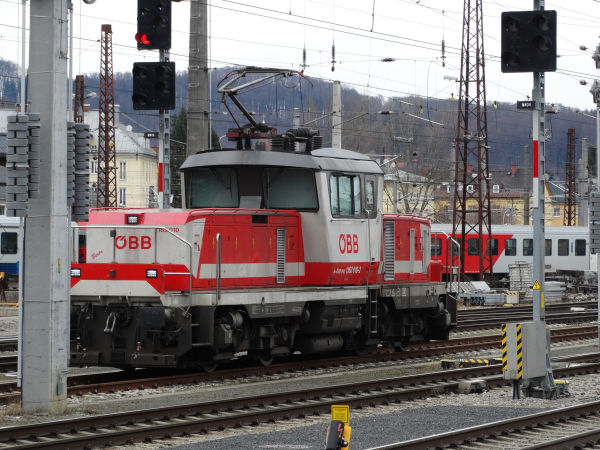
ÖBB class 1163 electric shunter at Salzburg station 14.3.2018. During the almost nine years that it took for the industry to deliver
to ÖBB the electric shunters of class Br1063, technology was developed further. This 1163 is a further development of the prior series.
20 of these newer locomotives were built in 1994. They have new asynchronous motors and bigger windows to allow for a better visibility
in all directions. The machine can produce 1600 kW of power and its top speed is 100 km/h. They are mostly used in shunting, but
occasionally also with local passenger and cargo services on the mainlines.
Photo by Ilkka Siissalo.
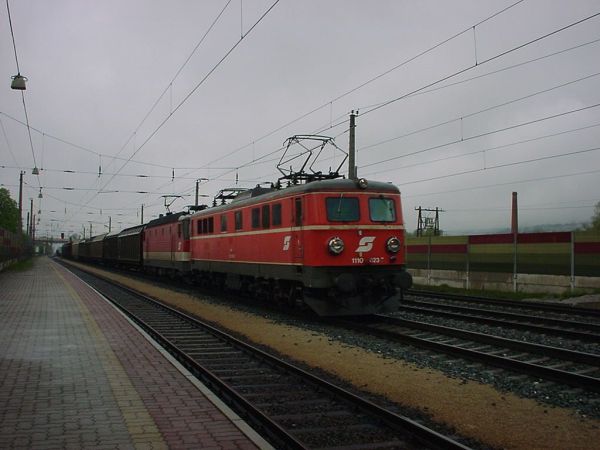
An old ÖBB class 1110 together with a class 1044 or 1144 hauling a cargo train somewhere on the line between Innsbruck and Kufstein
towards Germany on 25.4.2002. This is something one cannot see anymore, except for museum trains. The classes 1110 and 1110.500
were built 1956-61 by a consortium AEG, BBC, ELIN and Siemens. They wee intended for express train use, but their top speed was
limited to 110 km/h. With the emergence of the class 1044/1144 they were quickly pushed aside to not-so-relevant services. Six of
these locomotives have survived in various museum train arrangements.
Picture by Ilkka Siissalo 25.4.2002.
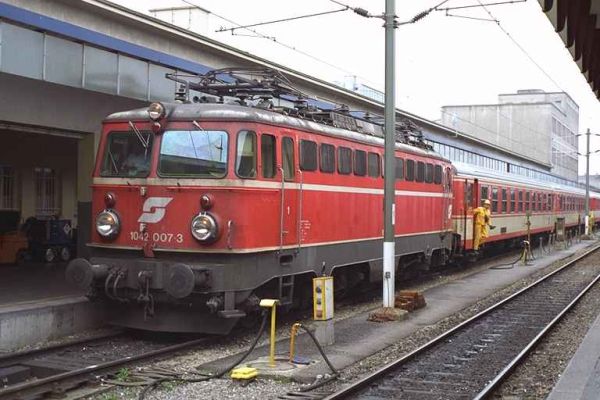
ÖBB 1042 007-3 in Wien Westbahnhof. 22 September 1995.
Photo by Erik Hjelme,
Uploaded Nov 23, 1995. These trains are history by now. They were very important for ÖBB in the 1960s and 1970s.
Here we see one still with the original large lamps. 1963-1977 altogether 257 locomotives of this type were built
by Siemens, ELIN, BBC and SGP Graz. In the 1990s a number of them were modernised to become the class 1142, which was used
for a long time for example in commuter traffic near Wien with double decker coaches. A couple of 1042s have survived
for example in Germany and in Switzerland in private ownership.
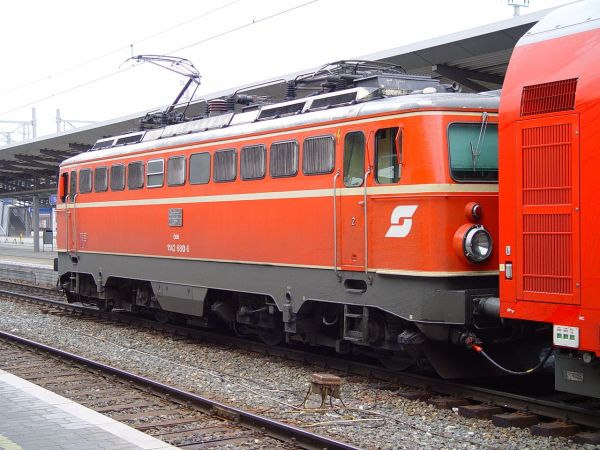
An old class 1142 leading a rake of double decker coaches in a local commuter train service.
Photo at Wiener Neustadt station 31.12.2002 by Ilkka Siissalo.
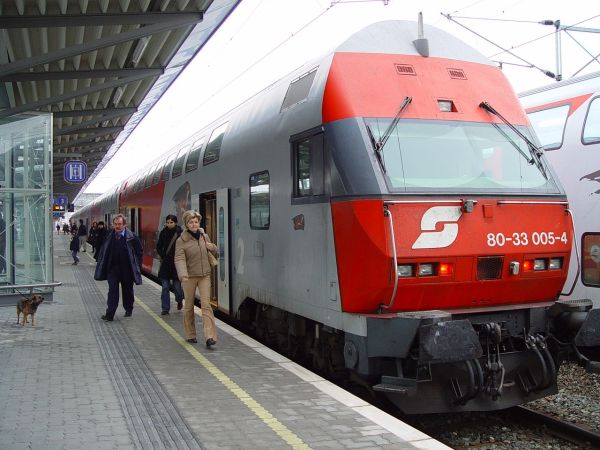
Same train as above, seen from behind. The last coach is a double decker steering wagon. The locomotive itself cannot be seen
at the end of the train.
Photo at Wiener Neustadt station 31.12.2002 by Ilkka Siissalo.
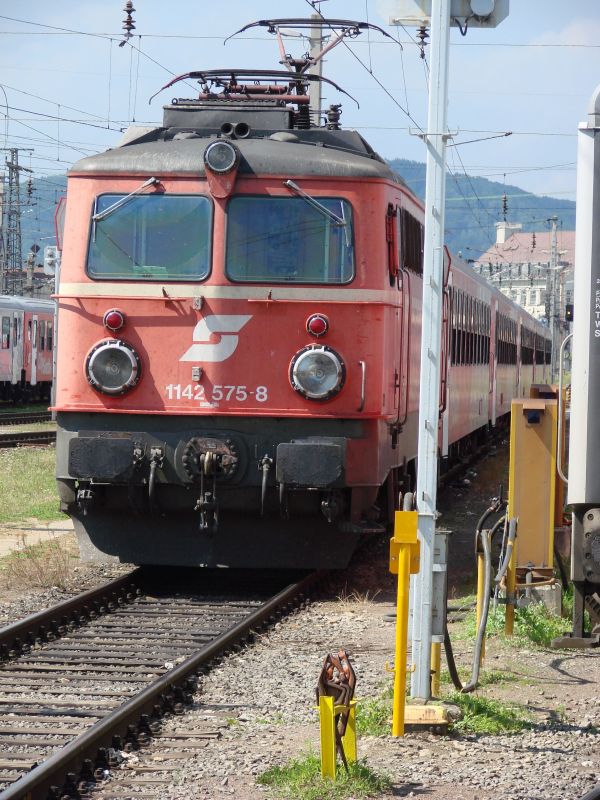
Another class 1142, surprisingly still in use, with a rake of CityShuttle commuter train coaches at Graz station 8.7.2007.
Photo by Ilkka Siissalo.
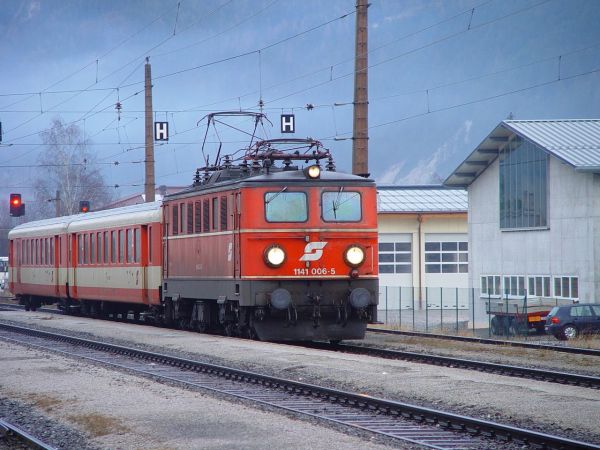
This used to be a typical Austrian local commuter train long ago, a class 1141 electric leading two old coaches.
The class 1141 was built by a consortium including BBC, SGP, Elin, AEG and others 1955 to 1958. It had a top speed of
110 km/h and had a 2480 kW power rating. They were scrapped 2003. This "last minute" photo is from Radstadt station
30.12.2002. Picture by Ilkka Siissalo.
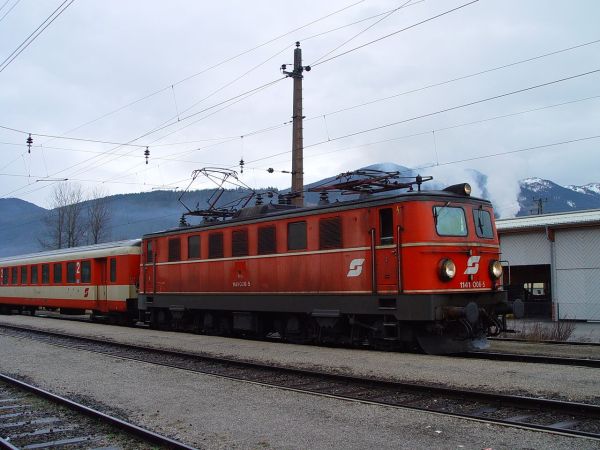
Another view of the old class 1141 at Radstadt station 30.12.2002. Picture by Ilkka Siissalo.
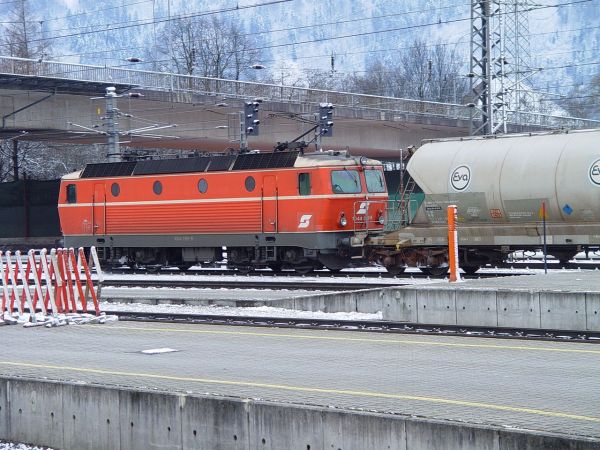
The class 1044 and its push-pull version counterpart, class 1144, were until the late 1990s the most common locomotives
in front of prime express trains, until the emergence of the new Siemens Taurus family locomotives. Here
1044.099 - still in the older blutorange (blood orange) colour scheme has been degraded to pull a local cargo
train instead of the fancier expresses.
Picture at Bludenz station 5.1.2003 by Ilkka Siissalo.
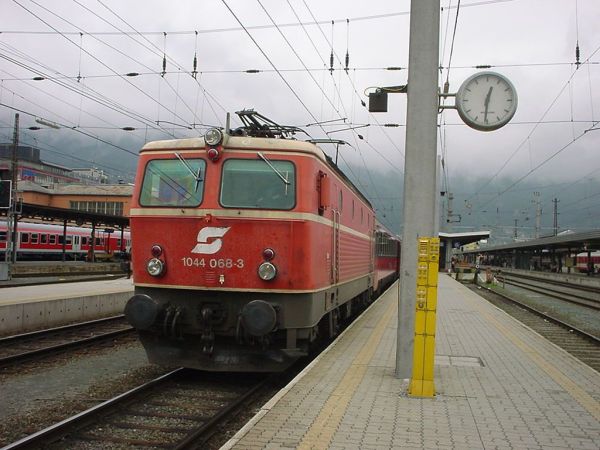
A class 1044 in front of an IC train at Innsbruck station 25.4.2002. Before ÖBB began receiving new Taurus
electric locomotives, the 1044 or 1144 was the most common locomotive in front of fast express services.
This one is still in its old "Blutorange" color scheme.
Picture 25.4.2002 in Innsbruck by Ilkka Siissalo.
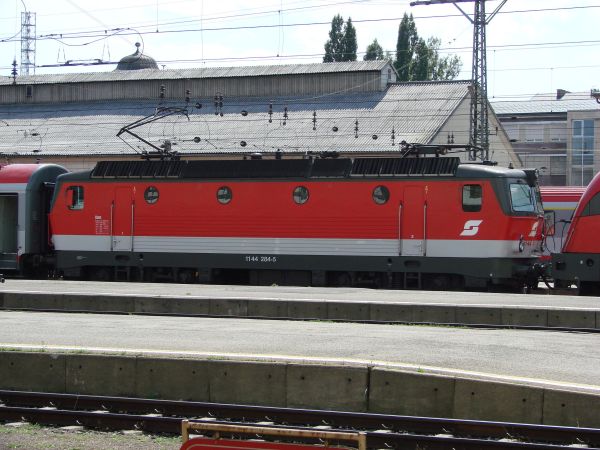
A class 1144 in its latest colouring scheme ready to haul together with a Taurus an express train over the
mountains from Graz south to Italy.
Photo at Graz station 8.7.2007 by Ilkka Siissalo.
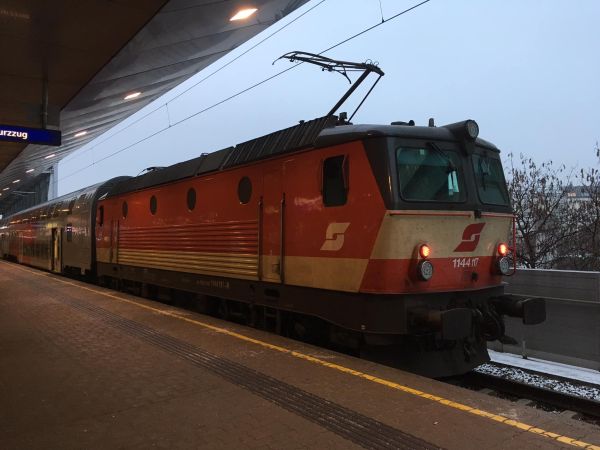
This class Br1144 locomotive number 117 is seen here in a very special but nice looking special livery which was called
the checkerboard painting. Apparently only two machines were painted in this scheme (117 and 092?) but the company Roco
made the painting scheme famous by publishing a model train with this design and selling thousands of them.
Picture from Wien Paterstern station 23.12.2016 by David J. Dro.
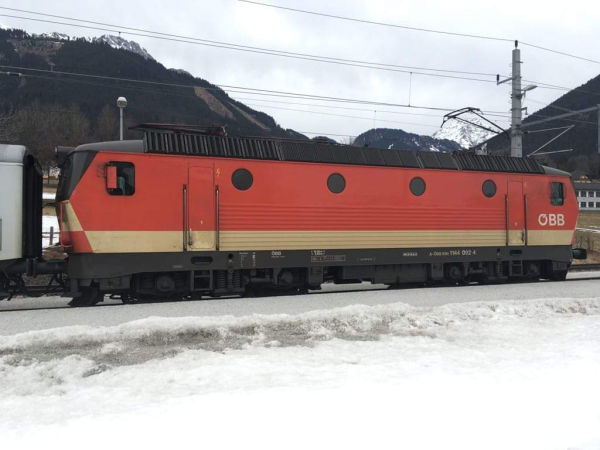
This is the other one of the only two Br1044/1144 in the experimental checkerboard livery. This is the locomotive 1144 092.
Picture from Ardning 26.2.2017 by David J. Dro.
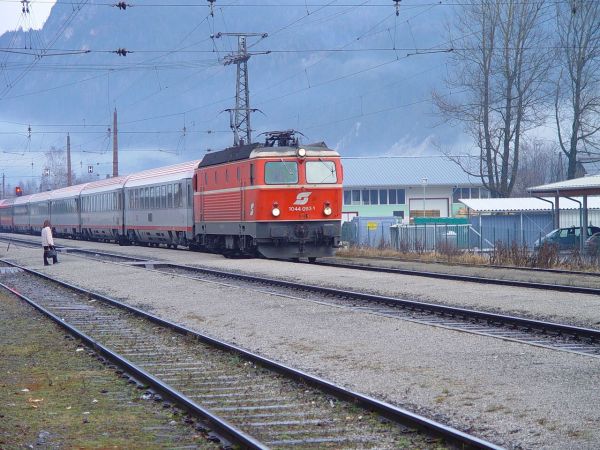
A typical IC express train of the time, a class 1044 locomotive leads a rake of express coaches, most of which have
already received the newer grey and red painting. One coach towards the end of the train still has the older
red and blackish grey painting. The picture is from Radstadt 30.12.2002. Since then, Tauruses of classes 1016
and 1116 have replaced most 1044s and new Railjet coaches have replaced most of these coaches. A large number
of these coaches have been sold for example to Belgium and also to Czech republic.
Picture 30.12.2002 by Ilkka Siissalo.
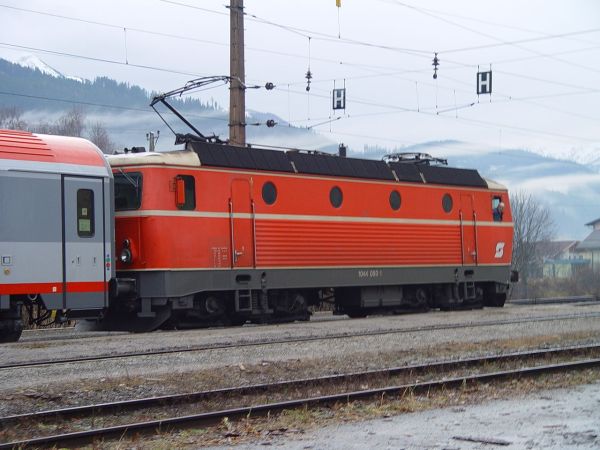
Another view of the class 1044 locomotive.
Picture at the Radstadt station 30.12.2002 by Ilkka Siissalo.
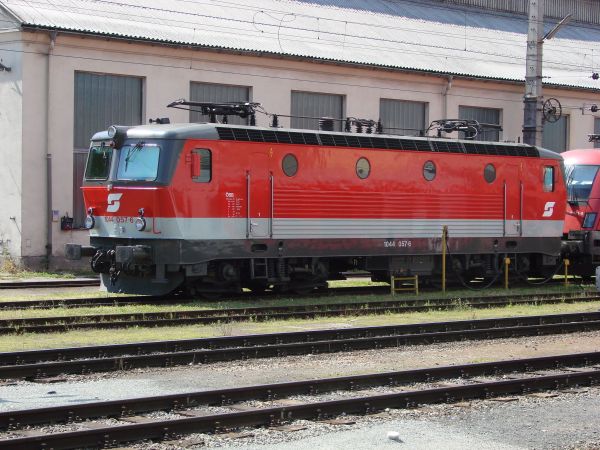
A freshly repainted class 1044 at the Graz main station 8.7.2007. Picture by Ilkka Siissalo.
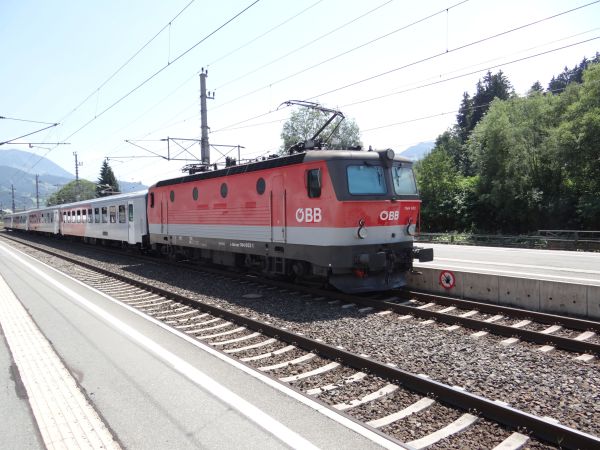
One of the Br 1144 locomotives, now in the latest (but already quite faded) livery,
leading a regional express train to St Johann in Tirol station 7.7.2015. Photo by Ilkka Siissalo.
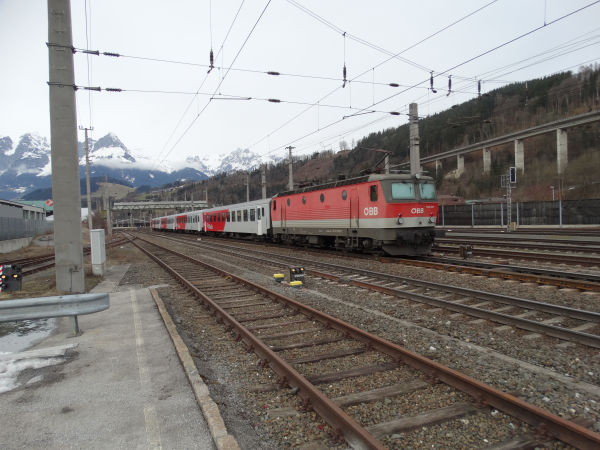
A Br1144 locomotive pushing a "CityShuttle" light regional train, here just preparing to stop at Bischofshofen station.
The classes 1044 and 1144 were designed for fast express train use, but now that there are a lot of newer Taurus locomotives
available, they have been mostly put to run not so important services, like this regional train here. ÖBB bought from 1976 to
1995 altogether 217 of these 160 km/h fast and 5120 kW strong machines. Due to their very loud humming noise, they soon got
the nickname "Österreichischer Alpenstaubsauger" (Austrian Alp dust vacuum cleaner). They are thyristor driven, modern locomotives.
Nowadays more or less every 1044 has been modified to enable push-pull use of passenger trains and these push-pull version
machines were reclassified as Br1144 instead of 1044. Otherwise they are the same type.
Picture from Bischofshofen 14.3.2018 by Ilkka Siissalo.

By 2018 all of ÖBB's former class 1044 locomotives have been fitted with remote steering to make them compatible with push-pull traffic
with steering cab coaches. Here is one of them, now classed as Br1144 after the modification. It has also received new LED lamps.
Picture from Krems an der Donau station 16.3.2018 by Ilkka Siissalo.

The Taurus family of locomotives is from the factories of Siemens. The initial model, now known as Taurus 1, is the
ÖBB class 1016, shown on the left in this picture, with still the old "snail" logo of ÖBB. The locomotive on the right
is class 1116 or second generation Taurus. The key difference of these is that class 1116 is dual voltage, that is, it can
operate also in Hungary. The first 1116s had four pantographs, but later models such as this no. 97 have just two.
Notice the new ÖBB logo on the 1116 on the right. The first and second generation Tauruses have doors for the driver
close to the middle of the locomotive, whereas 3. generation Tauruses have a door close to the cab.
Picture at Bludenz station 5.1.2003 by Ilkka Siissalo
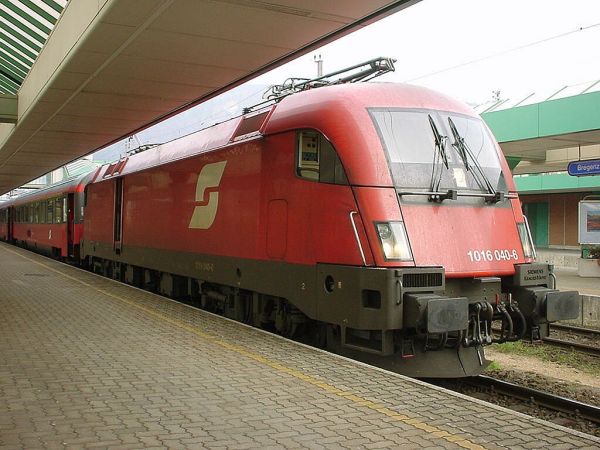
A then brand new first generation Taurus of class 1016 at the Bregenz station 30.3.2002. Note the old style ÖBB logo
nicknamed "snail". Picture by Ilkka Siissalo.
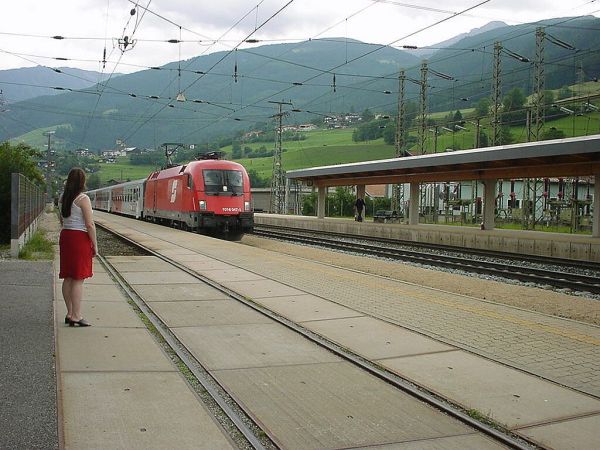
The regional trains around Innsbruck in 2002 were known by the marketing name CityShuttle Tirol. Here one of those services
has climbed up the Brenner route up to the station of Matrei. The lady in the picture is train photographer Sanna Siissalo.
Picture in Matrei 5.7.2002 by Ilkka Siissalo.

Same train as in the picture above.
Picture in Matrei 5.7.2002 by Ilkka Siissalo.
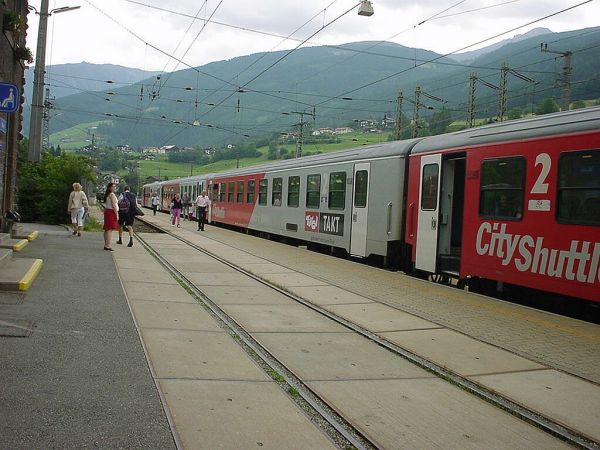
Still the same train as in the pictures above.
Picture in Matrei 5.7.2002 by Ilkka Siissalo.
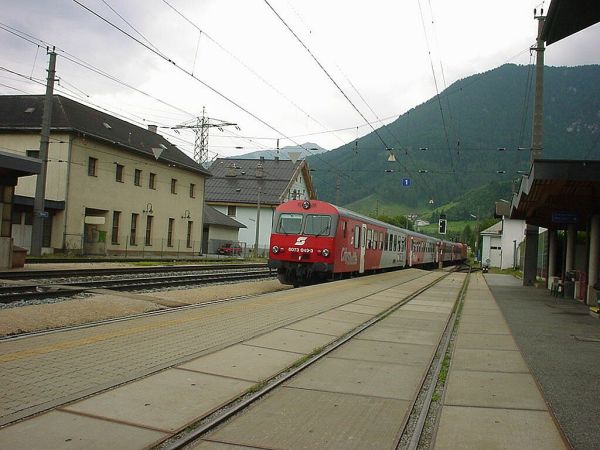
And still the same train as in the pictures above, but this time showing the driving trailer at the other end of the
push-pull rake of wagons. Picture in Matrei 5.7.2002 by Ilkka Siissalo.
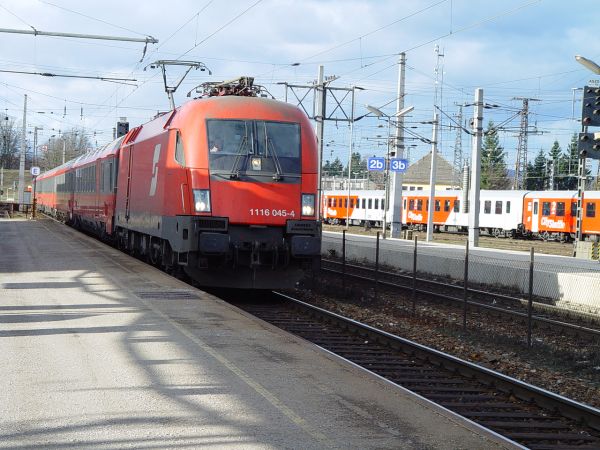
A second generation Taurus of class 1116 later series with just two pantographs instead of four, but still with the old snail logo
and old blackish grey + red coaches on an IC express train service from St Pölten to Wien. Photo 3.1.2003 at St Pölten station
by Ilkka Siissalo.
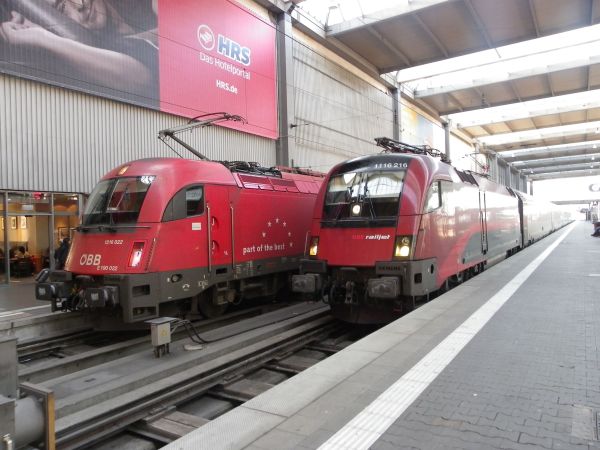
Two ÖBB Tauruses in München, Germany. The machine on the left is a third generation class 1216, which can easily be recognised by the
drivers' door close to the cab instead of at the middle of the locomotive. This is a four electric systems machine, capable
of running not only in Austria, but also in Germany, Switzerland, Italy, Slovenia, Hungary and Czech republic. The machine on the right
is a dual electricity system second generation Taurus, class 1116, painted in Railjet colours. The Railjet is probably Austria's
most famous train these days. They are fixed formations of Siemens made coaches and one Siemens made Taurus. Photo at München Hauptbahnhof
16.11.2012 by Ilkka Siissalo.

A typical Railjet composition of a class 1116 Taurus and Siemens made special coaches. At the other end is a specially designed
driving trailer with a cab that very much looks like a Taurus locomotive.
Photo at München Hauptbahnhof 16.11.2012 by Ilkka Siissalo.
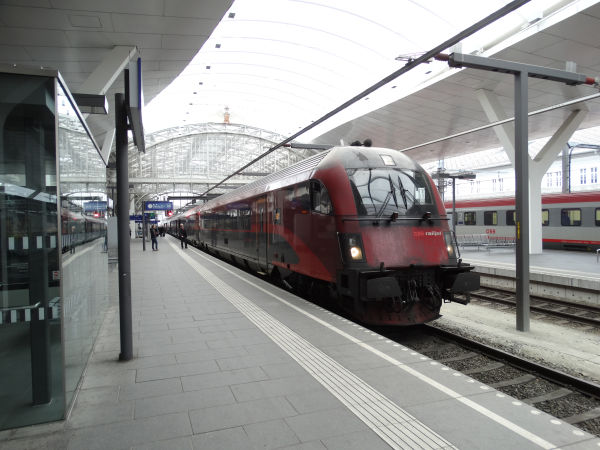
A rather dirty RailJet composition ready to leave towards Wien airport steering cab coach first.
Photo at Salzburg Hauptbahnhof 14.3.2018 by Ilkka Siissalo.
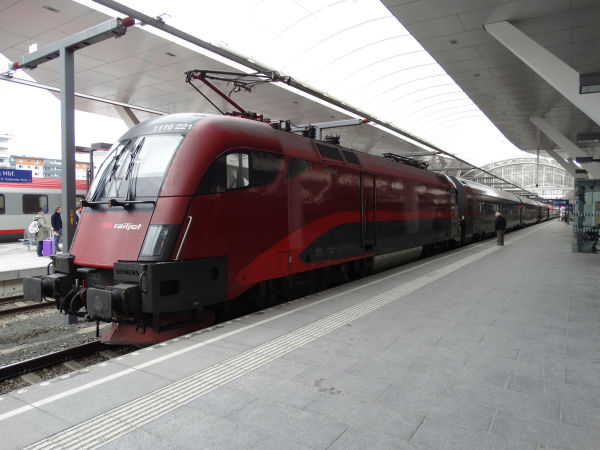
The same RailJet as above, but now seen from the pushing locomotive side.
Photo at Salzburg Hauptbahnhof 14.3.2018 by Ilkka Siissalo.
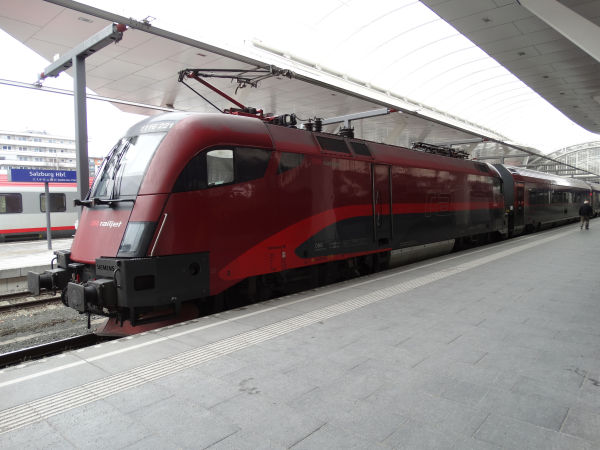
Still the same RailJet as above. Note that these special RailJet Tauruses are not quite identical with "standard" second generation
Siemens Taurus locomotives. The silver coloured "box" below its belly is the most obvious difference. They also have a third pantograph
for operations in Switzerland which standard Tauruses don't have. Later on ÖBB took also quite standard, unmodified class Br1116
Tauruses into Railjet use, but those cannot operate in Switzerland.
Photo at Salzburg Hauptbahnhof 14.3.2018 by Ilkka Siissalo.
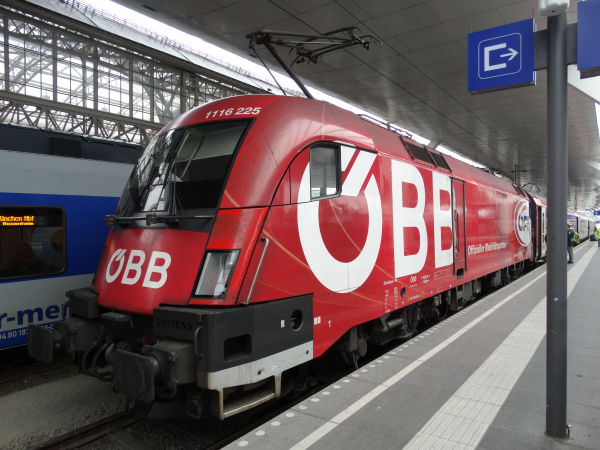
Austrians are quite football crazy and ÖBB is one of the official sponsors of their national team. One RailJet composition got therefore
a special painting and stickers, where each one of the coaches is displaying large advertisements of all the other official sponsor
organisations. This is the football-RailJet.
Photo at Salzburg Hauptbahnhof 14.3.2018 by Ilkka Siissalo.

Note that the Taurus locomotive of this special football-RailJet is lacking all the special RailJet features: It has only two pantographs
and no special "silvery box" extra protection plates underneath.
Photo at Salzburg Hauptbahnhof 14.3.2018 by Ilkka Siissalo.
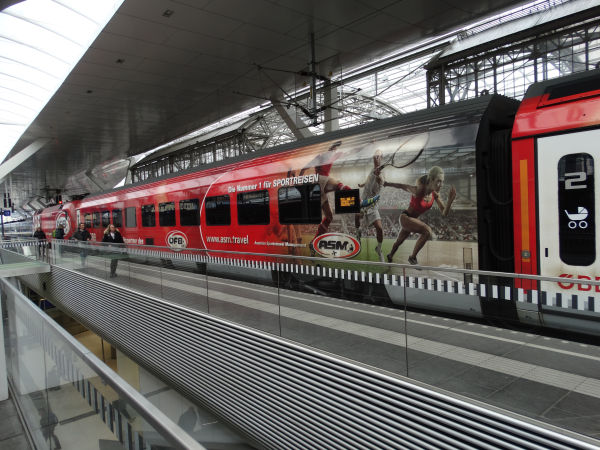
Each one of the other official sponsor organisations got its own coach for its own advertisements. Here a travel agency.
Photo at Salzburg Hauptbahnhof 14.3.2018 by Ilkka Siissalo.

The football-Railjet composition is full of all possible colours, but the end result is far from attractive. If this is how the railway
companies themselves treat their coaches, it's no wonder that some people think they can freely spray graffiti smudge all over them.
Photo at Salzburg Hauptbahnhof 14.3.2018 by Ilkka Siissalo.
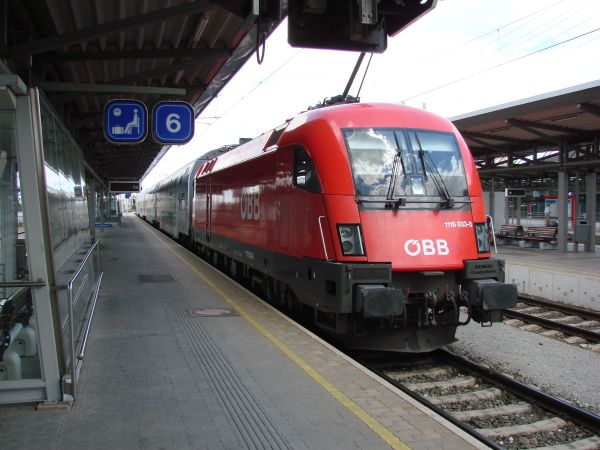
By the year 2007 new Tauruses had pushed aside the old class 1042s and 1046s from double decker commuter services at Wiener Neustadt.
Photo of the second generation class 1116 Taurus 8.7.2007 at Wiener Neustadt Hauptbahnhof by Ilkka Siissalo.
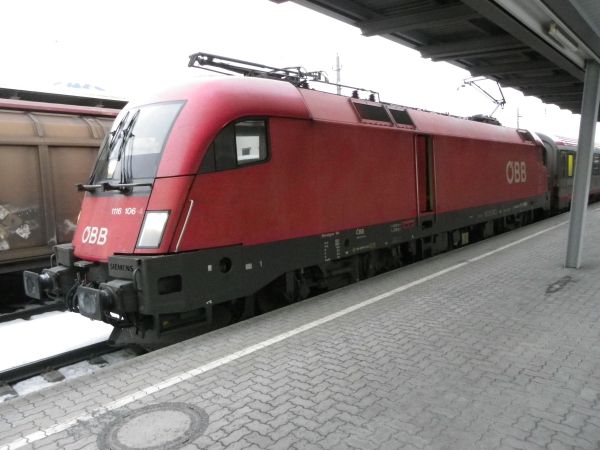
Another second generation class 1116 Taurus at the Bludenz station 27.1.2013 ready to leave direction Switzerland in front of an InterCity
or EuroCity train.
Photo at Bludenz station by Ilkka Siissalo.
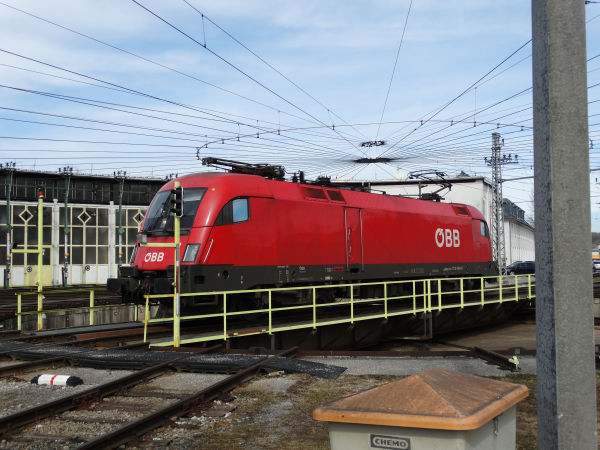
Another Br 1116 second generation Siemens Taurus, now with the newer ÖBB logo, in front of the locomotive stable at Salzburg Hauptbahnhof.
Picture by Ilkka Siissalo 15.3.2018.
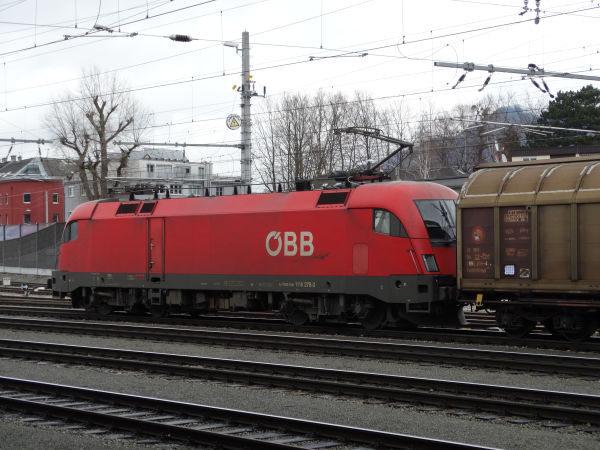
Another multiple electric systems Taurus of the class Br1116 leading a long cargo train through the main station of Salzburg.
Picture by Ilkka Siissalo 14.3.2018.
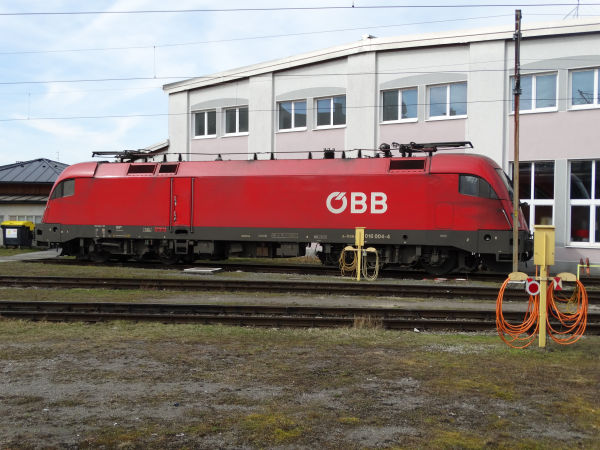
A first generation Siemens Taurus, class Br1016 with the new logo in front of the locomotive shed at Salzburg Hauptbahnof. Br1016 can only
operate on 16 kV in Austria, Germany and Switzerland, whereas Br1116 can additionally operate with 25 kV in Hungary.
Picture by Ilkka Siissalo 15.3.2018.
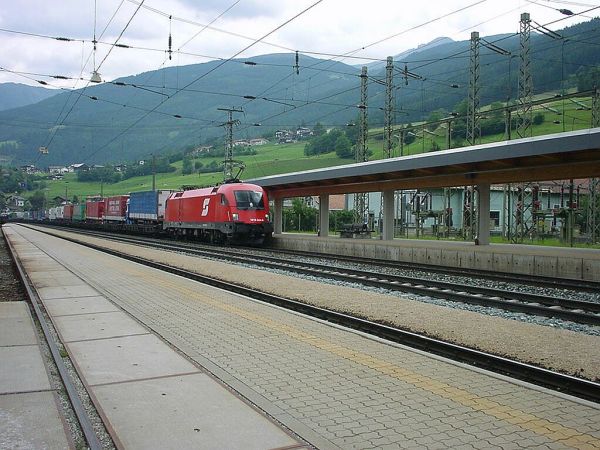
A "Rollende Landstrasse" (rolling road) service hauling lorries over the Alps via the Brenner route. It was typical of the time to have
an ÖBB Taurus locomotive (here class 1016) pulling and a DB class 150 or 151 pushing at the back of the train to get them up the steep slopes.
Picture from Matrei station 5.7.2002 by Ilkka Siissalo.
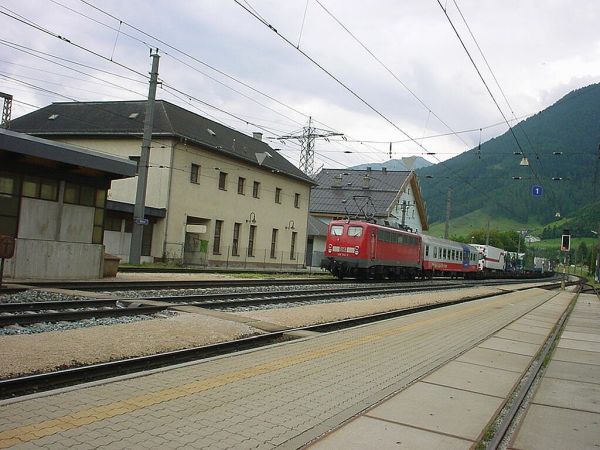
Same train as above, but now showing the pushing DB class 150 locomotive. Note also the coach next to the locomotive: this is a resting
place for the lorry drivers while their cars are hauled over the Alps.
Picture from Matrei station 5.7.2002 by Ilkka Siissalo.
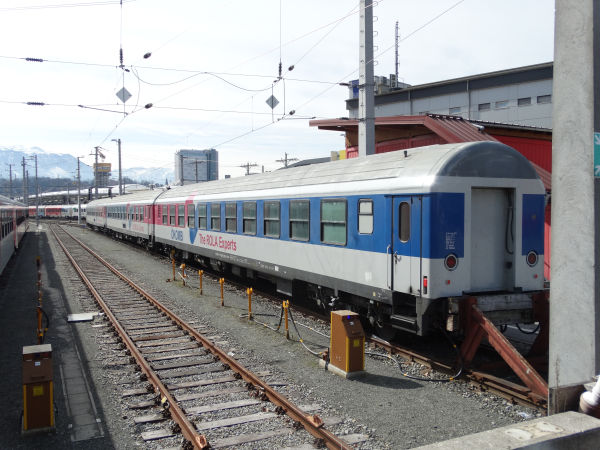
For years and years the Rollende Landstrasse (rolling highway) or ROLA services over the Alps were marketed under the brand of ÖKOMBI, a specialised
subsidiary of state railways ÖBB carrying lorries over the mountains. In 2013 however, ÖKOMBI was fused with Rail Cargo Austria (former ÖBB Cargo).
These sleeping coaches for lorry drivers are still branded with the old ÖKOMBI tapings although ÖKOMBI had ceased to exist already four years
earlier. These are former ÖBB night train sleeper coaches, here waiting for their next ROLA train ride over the Alps. Picture from Salzburg ROLA
yard 15.3.2018 by Ilkka Siissalo. In the background CityShuttle regional train coaches at Salzburg Hauptbahnhof.
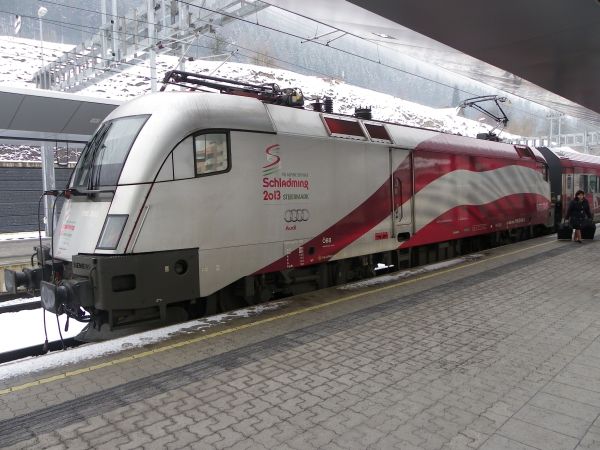
At the beginning of 2013 one of the Railjet compositions got a whole train long taping of a wavy Austrian flag due to the Alpine ski
competions at Shladming in Steiermark. The composition became fairly popular and trainspotters ran after it throughout the country.
Some companies even produced H0 scale miniature trains based on it - with incredible prices. This is the class 1116 Taurus of the special
composition, photographed by Ilkka Siissalo at the Bludenz station 28.1.2013.
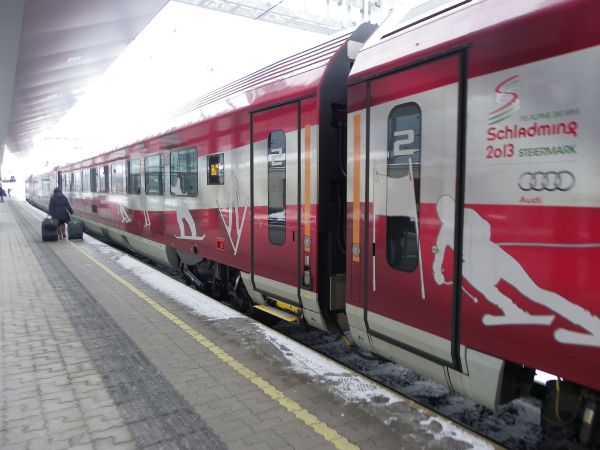
Coaches of the same wavy Austrian flag taped special Railjet composition photographed by Ilkka
Siissalo at the Bludenz station 28.1.2013.
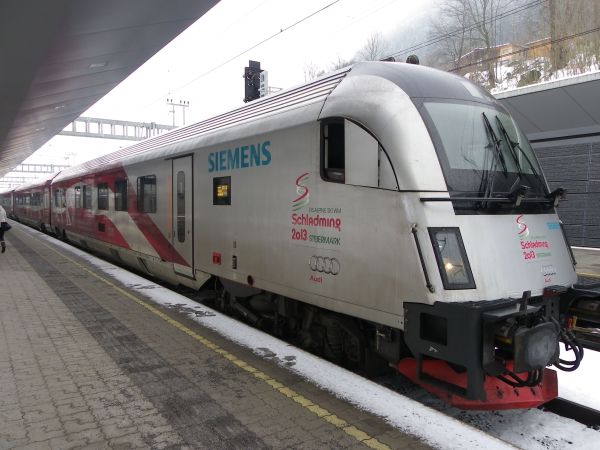
Driving trailer of the same Austrian wavy flag taped Railjet composition photographed by Ilkka
Siissalo at the Bludenz station 28.1.2013.

Before buying Tauruses, ÖBB bought a small series of 18 locomotives of the class 1014 built by SGP and Elin
in 1993-94. There was also an even smaller series of similar, but multiple electric system locomotives. These were
later considered to be too expensive and a bad buy. They were used in ÖBB's own use
only until 2009, when they were taken out of service. Most were sold to Romania for scrapping in 2016.
Some have been later used at private operators in Sweden, Poland and Slovenia. This one seen here is still a class 1014
in local commuter traffic at Wien Südbahnhof 2.1.2003.
Photo by Ilkka Siissalo.
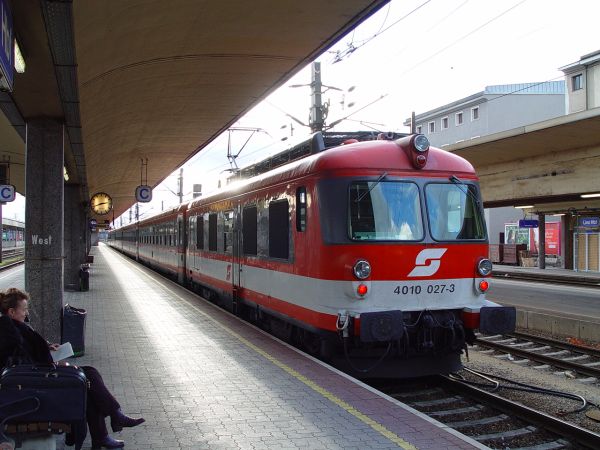
This is a famous train. It is - or rather was - the ÖBB class 4010, which looked like an EMU, but which actually was a fixed set of
a special locomotive and fitting coaches. It used to be called the TransAlpin, and when they were new, they were the premium luxury
trains between Switzerland and Austria. In those days they were blue and white. Here we see a TransAlpin set in its newer red and white livery
arriving at the Linz station 3.1.2003. These locomotives do not exist any more, but a German private operator bought the rakes of coaches
and after much trouble plus one bankruptcy renovated them. The idea was to use them in the private HKX Hamburg-Köln Express. But practise
soon showed that they were too luxurious and too expensive for a budget price company to operate.
Photo in Linz 3.1.2003 by Ilkka Siissalo.
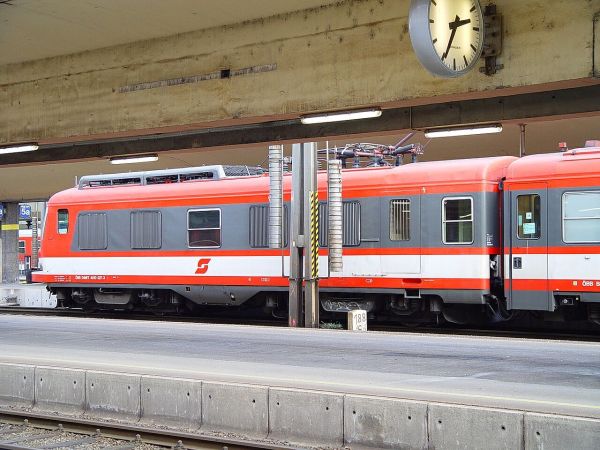
A side view of the class 4010 TransAlpin locomotive, or rather engine car.
Photo in Linz 3.1.2003 by Ilkka Siissalo.
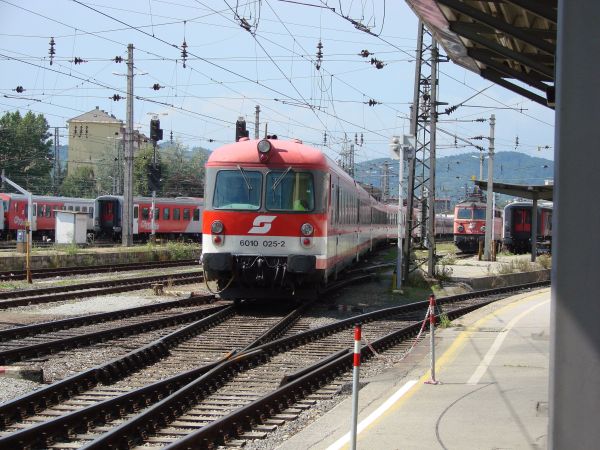
Another TransAlpin, this time the Br4010 no.007 approaching Graz station with its driving trailer first. The driving trailer has the
class number 6010, whilst the engine coach is always class 4010. This was the IC service "Karl Böhm" to Salzburg. Note that the driving trailer
had been loaned from train no. 025 while the rest of the train was the number 007. This was one of the very last days of operation of the
TransAlpins. Photo in Graz 8.7.2007 by Ilkka Siissalo.
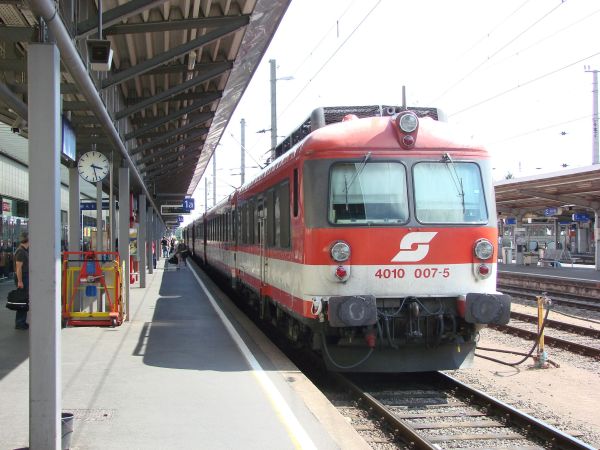
The TransAlpin was still a nice looking train in 2007, although it was reaching its last days of operational life.
Photo of Br4010 no. 007 at Graz station en route to Salzburg 8.7.2007 by Ilkka Siissalo.

